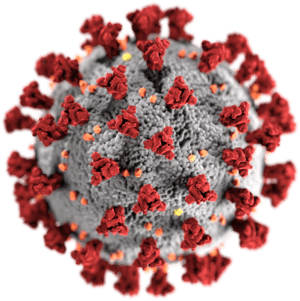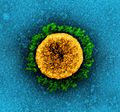Severe acute respiratory syndrome coronavirus 2 facts for kids

Severe acute respiratory syndrome coronavirus 2 (SARS-CoV-2), previously known by the provisional name 2019 novel coronavirus (2019-nCoV), is a strain of positive-sense single-stranded RNA virus. It is contagious in humans and is the cause of the ongoing 2019–20 coronavirus pandemic, a worldwide epidemic of coronavirus disease 2019 (COVID-19) that has been designated a Public Health Emergency of International Concern by the World Health Organization (WHO).
SARS-CoV-2 has close genetic similarity to bat coronaviruses, from which it likely originated. An intermediate reservoir such as a pangolin is also thought to be involved in its introduction to humans. From a taxonomic perspective SARS-CoV-2 is classified as a strain of the species severe acute respiratory syndrome-related coronavirus (SARSr-CoV).
Because the strain was first discovered in Wuhan, China, it is sometimes referred to informally as the Wuhan coronavirus, although the World Health Organization (WHO) discourages the use of names based upon locations. To avoid confusion with the disease SARS, the WHO sometimes refers to the virus as "the virus responsible for COVID-19" in public health communications.
Images for kids
-
Samples taken from Rhinolophus sinicus, a species of horseshoe bats, show an 80% resemblance to SARS‑CoV‑2.
-
Transmission electron micrograph of SARS‑CoV‑2 virions (red) isolated from a patient during the COVID-19 pandemic
See also
 In Spanish: SARS-CoV-2 para niños
In Spanish: SARS-CoV-2 para niños






